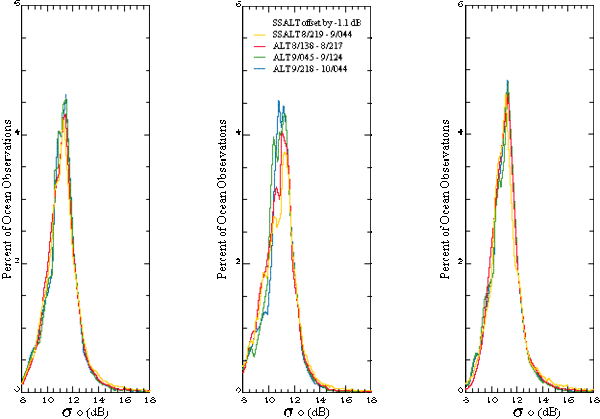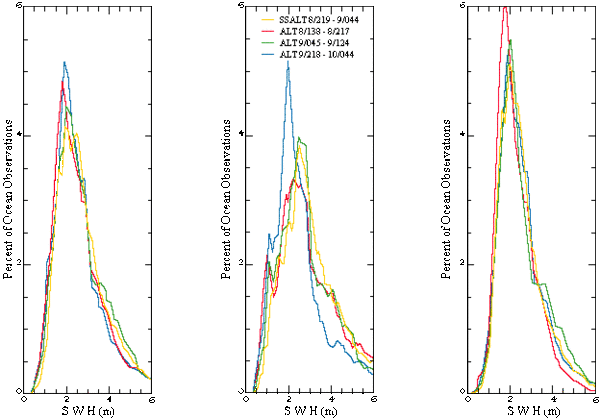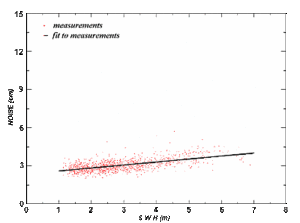Poseidon Altimeter: great results after six months in orbit
Ouan-Zan Zanifé (CLS, France)
Poseidon was switched on 15 times between August 21, 1992 and March 1, 1993, in accordance with the time-sharing plan with the Nasa altimeter. Altogether it was on for 650 hours, or about 13% of the time.
All the switch-ons were flawless and all the 1200 commands sent to Poseidon and the 13 mode switch-overs were executed successfully.
In the hour following switch-on, the mean operating temperature reached around 26°C.
The altimeter is being monitored via conventional parameters such as temperature and current, but also via two internal calibration modes, CAL I and CAL II. These are for measurements of the altimeter pulse response (CAL I) and low-pass filter response (CAL II).
The parameters used in CAL I include delay through the altimeter and total power, used to calculate the backscattering coefficient. Changes in these parameters over time show the great stability of the altimeter after the transitory phases. Since the first switch-on, the instrument delay has varied by only 0.3 cm and total power by 0.2 dB in six months. In any case, comparing the measured pulse response with the theoretical response of (sin x / x2) reveals any doubtful changes. We have detected no anomalies. CAL II mode, as well as monitoring changes in the low-pass filters, is used to extract coefficients used in the attitude computation. This mode also shows that the altimeter is extremely stable.
The "highest" level of altimeter monitoring concerns performance. This check is done using the raw data, statistics, histograms or more sophisticated software (crossover points, time-tagging bias). Recall that tracking can be split into two phases:
- acquisition phase, i.e. searching for the signal, locking onto it and stabilizing the tracking loops,
- tracking phase proper, i.e. holding the signal in a window and accurately estimating altimeter parameters.
The acquisition phase lasts 0.7 to 1.5 seconds, mainly according to the satellite's position on its orbit. Figures 1 and 2 show histograms of wave height and backscattering coefficients during the tracking phase. As with most altimeters, the wave distribution measured by Poseidon peaks at 2 m, while the backscattering coefficient distribution is shifted by about 1 dB relative to the distributions given by Geosat (no empirical bias was introduced to agree with Geosat). Comparisons with Topex over equivalent periods show that the two altimeters measure the same physical parameters, in the same proportions.
We did several analyses to qualify the range measurement, the most sensitive measurement of the Topex/Poseidon mission.
The first was to determine the noise level of the raw data by spectral analysis. This is shown on Figure 3 according to wave height for 1-Hz data. Notice the linear dependence on wave height, as expected from earlier simulations. Further, for wave heights under 5 m, noise is under 3.5 cm.
The second method was to compute the rms deviation of crossover differences.
For the 3-day period, the rms deviation was 13 cm during the transition from cycle 8 to cycle 9 (same period as for histogram). Intrinsically this is a very good result, as it mainly consists of orbital error, but a more detailed analysis shows that we can still improve it. Most of the points are between +20 and -20 cm, with rms deviation around 7 cm (the points outside that range could be eliminated by refining the selection criteria). The first calculations using the crossover points reveal a time-tagging bias on the order of a millisecond. However, as there are not many points, these results are also accurate to within a few milliseconds and the actual time-tagging bias is very likely lower. This will be confirmed during the 10-day Poseidon cycle scheduled for early April.



Figure 3: Noise level of Poseidon altimeter in cm according to significant wave height (courtesy of Bruno Cugny).
In conclusion, the analyses conducted so far indicate that:
- the altimeter is extremely stable,
- sea surface measurements are accurate to within 3.5 cm,
- wave height measurements are accurate to within 20 cm,
- the backscattering coefficient is accurate to within 0.5 dB.




